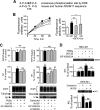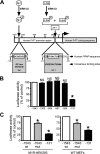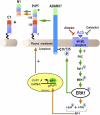The extracellular regulated kinase-1 (ERK1) controls regulated alpha-secretase-mediated processing, promoter transactivation, and mRNA levels of the cellular prion protein
- PMID: 21586567
- PMCID: PMC3190726
- DOI: 10.1074/jbc.M110.208249
The extracellular regulated kinase-1 (ERK1) controls regulated alpha-secretase-mediated processing, promoter transactivation, and mRNA levels of the cellular prion protein
Erratum in
- J Biol Chem. 2011 Sep 23;286(38):33708
- J Biol Chem. 2013 Jul 5;288(27):19646
Abstract
The α-secretases A disintegrin and metalloprotease 10 (ADAM10) and ADAM17 trigger constitutive and regulated processing of the cellular prion protein (PrP(c)) yielding N1 fragment. The latter depends on protein kinase C (PKC)-coupled M1/M3 muscarinic receptor activation and subsequent phosphorylation of ADAM17 on its intracytoplasmic threonine 735. Here we show that regulated PrP(c) processing and ADAM17 phosphorylation and activation are controlled by the extracellular-regulated kinase-1/MAP-ERK kinase (ERK1/MEK) cascade. Thus, reductions of ERK1 or MEK activities by dominant-negative analogs, pharmacological inhibition, or genetic ablation all impair N1 secretion, whereas constitutively active proteins increase N1 recovery in the conditioned medium. Interestingly, we also observed an ERK1-mediated enhanced expression of PrP(c). We demonstrate that the ERK1-associated increase in PrP(c) promoter transactivation and mRNA levels involve transcription factor AP-1 as a downstream effector. Altogether, our data identify ERK1 as an important regulator of PrP(c) cellular homeostasis and indicate that this kinase exerts a dual control of PrP(c) levels through transcriptional and post-transcriptional mechanisms.
Figures











Similar articles
-
Isoform-specific contribution of protein kinase C to prion processing.Mol Cell Neurosci. 2008 Nov;39(3):400-10. doi: 10.1016/j.mcn.2008.07.013. Epub 2008 Jul 29. Mol Cell Neurosci. 2008. PMID: 18722532
-
ERK1-independent α-secretase cut of β-amyloid precursor protein via M1 muscarinic receptors and PKCα/ε.Mol Cell Neurosci. 2011 Jul;47(3):223-32. doi: 10.1016/j.mcn.2011.04.008. Epub 2011 May 4. Mol Cell Neurosci. 2011. PMID: 21570469
-
Role of ADAMs in the ectodomain shedding and conformational conversion of the prion protein.J Biol Chem. 2009 Aug 21;284(34):22590-600. doi: 10.1074/jbc.M109.032599. Epub 2009 Jun 29. J Biol Chem. 2009. PMID: 19564338 Free PMC article.
-
Roles of endoproteolytic α-cleavage and shedding of the prion protein in neurodegeneration.FEBS J. 2013 Sep;280(18):4338-47. doi: 10.1111/febs.12196. Epub 2013 Mar 13. FEBS J. 2013. PMID: 23413979 Review.
-
The "A Disintegrin And Metalloproteases" ADAM10 and ADAM17: novel drug targets with therapeutic potential?Eur J Cell Biol. 2011 Jun-Jul;90(6-7):527-35. doi: 10.1016/j.ejcb.2010.11.005. Epub 2010 Dec 30. Eur J Cell Biol. 2011. PMID: 21194787 Review.
Cited by
-
Proteolytic processing of the prion protein in health and disease.Am J Neurodegener Dis. 2012;1(1):15-31. Epub 2012 May 15. Am J Neurodegener Dis. 2012. PMID: 23383379 Free PMC article.
-
A Bioengineering Strategy to Control ADAM10 Activity in Living Cells.Int J Mol Sci. 2023 Jan 4;24(2):917. doi: 10.3390/ijms24020917. Int J Mol Sci. 2023. PMID: 36674432 Free PMC article.
-
ADAM17 Is an Essential Factor for the Infection of Bovine Cells with Pestiviruses.Viruses. 2022 Feb 13;14(2):381. doi: 10.3390/v14020381. Viruses. 2022. PMID: 35215974 Free PMC article.
-
Unified theory of Alzheimer's disease (UTAD): implications for prevention and curative therapy.J Mol Psychiatry. 2016 Jul 15;4:3. doi: 10.1186/s40303-016-0018-8. eCollection 2016. J Mol Psychiatry. 2016. PMID: 27429752 Free PMC article. Review.
-
Transgenic Overexpression of the Disordered Prion Protein N1 Fragment in Mice Does Not Protect Against Neurodegenerative Diseases Due to Impaired ER Translocation.Mol Neurobiol. 2020 Jun;57(6):2812-2829. doi: 10.1007/s12035-020-01917-2. Epub 2020 May 4. Mol Neurobiol. 2020. PMID: 32367491 Free PMC article.
References
-
- Aguzzi A., Calella A. M. (2009) Physiol. Rev. 89, 1105–1152 - PubMed
-
- Linden R., Martins V. R., Prado M. A., Cammarota M., Izquierdo I., Brentani R. R. (2008) Physiol. Rev. 88, 673–728 - PubMed
-
- Chen S. G., Teplow D. B., Parchi P., Teller J. K., Gambetti P., Autilio-Gambetti L. (1995) J. Biol. Chem. 270, 19173–19180 - PubMed
-
- Forloni G., Angeretti N., Chiesa R., Monzani E., Salmona M., Bugiani O., Tagliavini F. (1993) Nature 362, 543–546 - PubMed
Publication types
MeSH terms
Substances
LinkOut - more resources
Full Text Sources
Molecular Biology Databases
Research Materials
Miscellaneous

